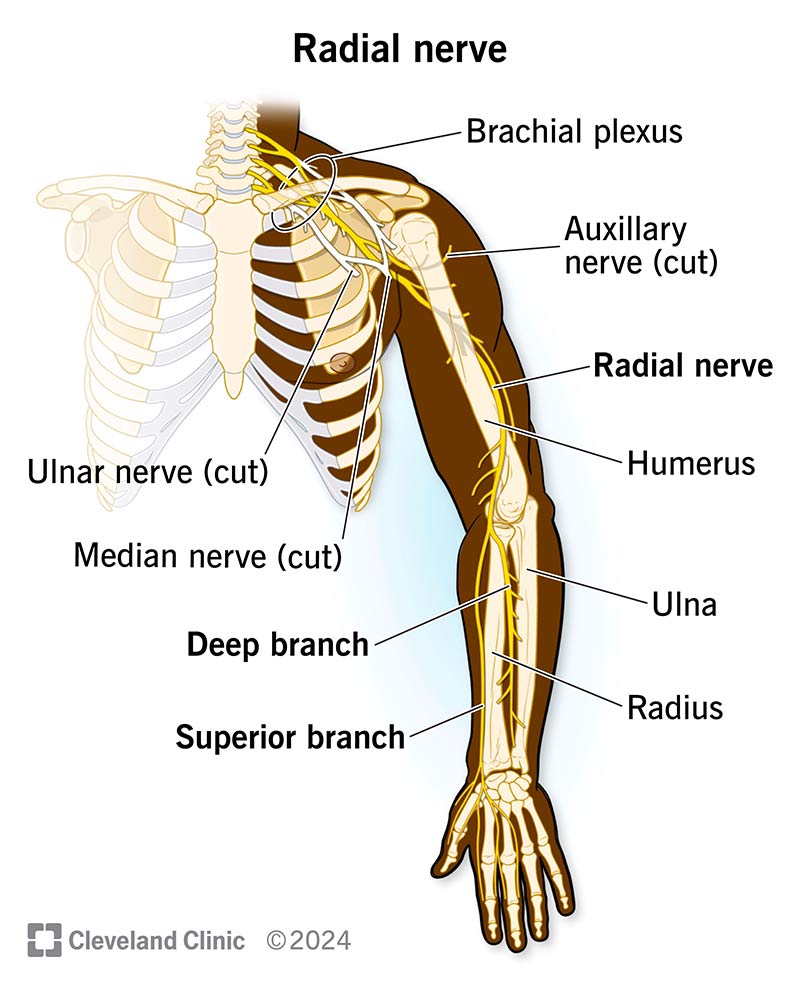Your radial nerve takes a winding path from your lower armpit to some of your fingers. It allows you to move muscles and feel skin sensations in certain parts of your upper arm, forearm, wrist and hand. Like other peripheral nerves in your body, your radial nerve can become damaged, causing symptoms like pain and muscle weakness.
Advertisement
Cleveland Clinic is a non-profit academic medical center. Advertising on our site helps support our mission. We do not endorse non-Cleveland Clinic products or services. Policy

Your radial nerve is a peripheral nerve that supplies movement and sensory function to parts of your arm, forearm, wrist and hand. You have a radial nerve in each of your arms. It’s called “radial” because part of it runs alongside the radius bone (and the radial artery) in your forearm.
Advertisement
Cleveland Clinic is a non-profit academic medical center. Advertising on our site helps support our mission. We do not endorse non-Cleveland Clinic products or services. Policy
Nerves are like cables that carry electrical impulses between your brain and the rest of your body. These impulses help you feel sensations and move your muscles.
The function of your radial nerve is to supply movement (motor) and sensory information between your brain and parts of your arm, wrist and hand.
The motor branch of your radial nerve stimulates the:
The sensory branch of your radial nerve provides touch, pain and temperature sensations for the skin on:
Some of the other nerves responsible for movement and sensations in your arm include your:
All of your peripheral nerves — including your radial nerves — are branches of other nerves in your body that originate from your spinal cord. If your spinal cord is the trunk of a tree, your peripheral nerves are its branches or roots. To understand your radial nerve, it helps to know where it starts and ends.
Advertisement
Your radial nerve is one of five nerve branches that extend from your brachial plexus. The brachial plexus nerves start from nerves that extend from your spinal cord (nerve roots) in your lower neck (cervical spine) and upper chest (thoracic spine). They travel underneath your collarbone (clavicle) and through your armpit.
Your radial nerve starts at your lower armpit. From there, it has a winding path, like a gently curving river. Your radial nerve:
At your elbow, your radial nerve splits into two major branches:
Certain conditions and problems can cause radial nerve injury. It typically happens when there’s pressure on your radial nerve, causing a pinched nerve and nerve (neuropathic) pain.
Conditions that affect your radial nerve include:
Advertisement
Symptoms of radial nerve damage can vary based on where your radial nerve is injured.
One consistent symptom is radial nerve pain (radial nerve neuropathy). You may have the following sensations in your arm, wrist and/or hand:
Other signs of radial nerve damage may include:
These steps can help keep your radial nerves — and your nervous system — healthy:
You should call a healthcare provider if you experience:
Advertisement
We often don’t think about our nerves until there’s a problem. Your radial nerve has the important job of providing certain movement and sensory functions to your arm. If you develop nerve pain or weakness in your arm, wrist or hand, it may be due to a radial nerve issue. Reach out to a healthcare provider if this happens. They can do some tests and assessments to see if your radial nerve is injured.
Advertisement
If you have a neurological condition, you want expert advice. At Cleveland Clinic, we’ll work to create a treatment plan that’s right for you.

Last reviewed on 04/11/2024.
Learn more about the Health Library and our editorial process.